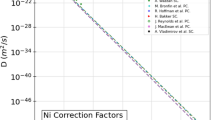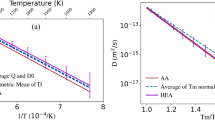Abstract
Intrinsic diffusion coefficients have been calculated for a solid solution binary fcc metal alloy with vacancies using grand canonical and kinetic Monte Carlo (MC) methods for a variety of model Hamiltonians. Model Hamiltonians include a kinetically and thermodynamically ideal case, solute-vacancy attraction and repulsion, and solute-solute attraction and repulsion. These model Hamiltonians are chosen to have constant average activation energies in order to focus on contributions from other thermodynamic and kinetic factors. The thermodynamic factor calculated using MC is compared to a mean-field regular solution model. It is shown that the mean-field model accurately predicts the thermodynamic factors for each model alloy Hamiltonian except for the alloys with a solute-solute interaction and concentration that are in the spinodal region (as predicted by the regular solution model). The MC determined concentration-dependent intrinsic diffusion coefficients are compared to values determined from the dilute five-frequency model and Darken and Manning analytical approximations. The results indicate that for a solid solution with known average barriers and vacancy concentration, Darken and Manning approximation-based analytic expressions and mean-field theory can be used to predict concentration-dependent diffusion coefficients within a factor of approximately three, provided the system is outside of the spinodal region. The good accuracy of this approximate approach follows from the fact that the thermodynamic factor is the main contribution to the concentration dependence of the diffusion constants, and that this thermodynamic factor is well described by mean-field theory.















Similar content being viewed by others
References
R.E. Howard and A.B. Lidiard, Matter Transport in Solids, Rep. Prog. Phys., 1964, 27, p 161-240.
A. Van der Ven, J.C. Thomas, Q. Xu, B. Swoboda, and D. Morgan, Nondilute Diffusion from First Principles: Li Diffusion in LixTiS2, Phys. Rev. B: Condens. Matter Mater. Phys., 2008, 78, p 104306.
J.R. Manning, Correlation Factors for Diffusion in Nondilute Alloys, Phys. Rev. B, 1971, 4(4), p 1111-1121.
A.B. Lidiard, Impurity Diffusion in Crystals (Mainly Ionic Crystals with the Sodium Chloride Structure), Philos. Mag., 1955, 46, p 1218-1237
A.D. LeClaire and A.B. Lidiard, Correlation Effects in Diffusion in Crystals, Philos. Mag., 1956, 1(6), p 518-527 (8th series).
A.D. LeClaire, Solute Diffusion in Dilute Alloys, J. Nucl. Mater., 1978, 69-70(1-2), p 70-96
V. Barbe and M. Nastar, Phenomenological Coefficients in a Concentrated Alloy for the Dumbbell Mechanism, Philos. Mag., 2006, 86(23), p 3503-3535
V. Barbe and M. Nastar, Phenomenological Coefficients in a Dilute BCC Alloy for the Dumbbell Mechanism, Philos. Mag., 2007, 87(11), p 1649-1669
A. Van der Ven and G. Ceder, First Principles Calculation of the Interdiffusion Coefficient in Binary Alloys, Phys. Rev. Lett., 2005, 94, p 045901.
A. Van der Ven and G. Ceder, Vacancies in Ordered and Disordered Binary Alloys Treated with the Cluster Expansion, Phys. Rev. B: Condens. Matter. Mater. Phys., 2005, 71, p 054102-1-054102-2.
A.R. Allnatt and E.L. Allnatt, Computer Simulation Study of the Manning Relations and Related Approximations in a Strictly Regular Solution Model, Phil. Mag. A, 1991, 64(2), p 341-353
A.R. Allnatt and E.L. Allnatt, Comparison of Computer Simulated and Theoretical Tracer Diffusion Coefficients for a Strictly Regular Solution Model of a Concentrated Alloy, Phil. Mag. A, 1992, 66(1), p 165-171
A. Van der Ven, G. Ceder, M. Asta, and P.D. Tepesch, First-Principles Theory of Ionic Diffusion with Nondilute Carriers, Phys. Rev. B: Condens. Matter. Mater. Phys., 2001, 64(18), 184307-1-184307-17.
G.K. Boreskov, Heterogeneous Catalysis, Nova Science Publishers Inc., New York, 2003
J.M. Yeomans, Statistical Mechanics of Phase Transitions. Clarendon Press/Oxford University Press, Oxford, New York, 1992.
J.M. Sanchez and D.d. Fontaine, The FCC Ising Model in the Cluster Variation Approximation, Phys. Rev. B, 1978, 17(7), p 2926-2936
A. Van der Ven, H.C. Yu, G. Ceder, and K. Thornton, Vacancy Mediated Substitutional Diffusion in Binary Crystalline Solids, Progr. Mater. Sci., 2010, 55(2), p 61-105.
A.R. Allnatt, Einstein and linear response formulae for the phenomenological coefficients for isothermal matter transport in solids, J. Phys. C: Solid State, 1982, 15, p 5605-5613
Y. Kakuda, E. Uchida, and N. Imai, A New Model of the Excess Gibbs Energy of Mixing for a Regular Solution, Proc. Jpn. Acad. Ser. B, 1994, 70(10), p 163-168
A.R. Allnatt and A.B. Lidiard, Atomic Transport in Solids, Cambridge University Press, Cambridge, 1993
L.S. Darken, Diffusion, Mobility and their Interrelation Through Free Energy in Binary Metallic Systems, Trans. AIME, 1948, 175, p 184-201.
G.E. Murch, Chemical Diffusion in Highly Defective Solids, Phil. Mag. A, 1980, 41(2), p 157-163
R. Kutner, Chemical Diffusion in the Lattice Gas of Non-Interacting Particles, Phys. Lett. A, 1981, 81(4), p 239-240
L.K. Moleko, A.R. Allnatt, and E.L. Allnatt, A Self-Consistent Theory of Matter Transport in a Random Lattice Gas and Some Simulation Results, Phil. Mag. A, 1989, 59(1), p 141-160
I.V. Belova and G.E. Murch, Collective Diffusion in the Binary Random Alloy, Phil. Mag. A, 2000, 80(3), p 599-607
Acknowledgment
We gratefully acknowledge financial support from the DOE Nuclear Engineering Research Initiative Program (NERI), award number DE-FC07-06ID14747.
Author information
Authors and Affiliations
Corresponding author
Rights and permissions
About this article
Cite this article
Swoboda, B., Van der Ven, A. & Morgan, D. Assessing Concentration Dependence of FCC Metal Alloy Diffusion Coefficients Using Kinetic Monte Carlo. J. Phase Equilib. Diffus. 31, 250–259 (2010). https://doi.org/10.1007/s11669-010-9706-8
Received:
Published:
Issue Date:
DOI: https://doi.org/10.1007/s11669-010-9706-8




